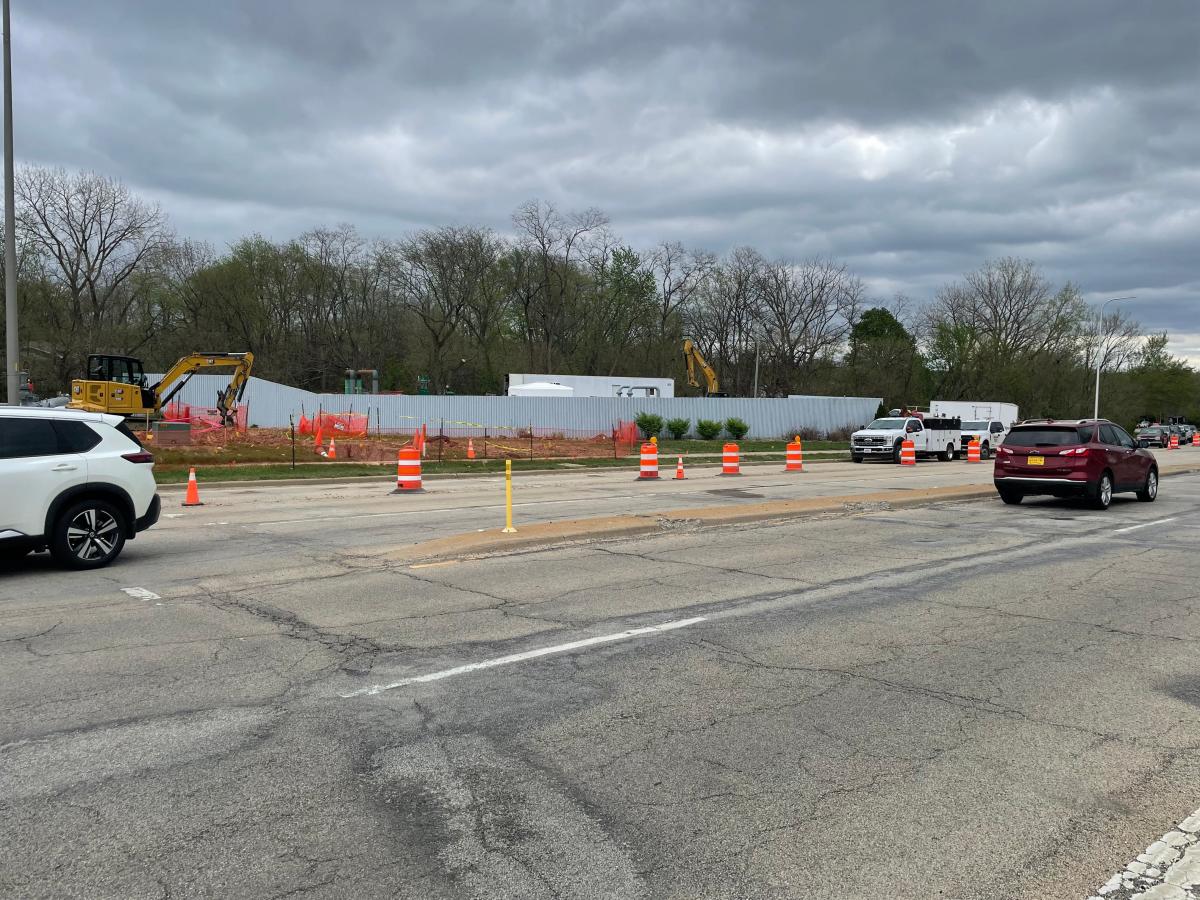Jun. 2—ASHLEY — American writer and humorist, Mark Twain, once said, “Buy land, they’re not making it anymore.”
Ellen Ferretti, Executive Director at the North Branch Land Trust and a former Secretary of the Pennsylvania Department Conservation and Natural Resources, paraphrased Twain’s advice about land.
“I say conserve and protect land — they’re not making it anymore,” Ferretti said. “It’s critical to appreciate, conserve and care for our natural resources and the fabric of the wild that brings clean air and water, beauty and enjoyment to our lives for our health and well-being now and that of generations of people, plants and all manner of wildlife yet to come.”
Ferretti met with Pennsylvania’s new State Forester, Seth Cassell, this week at the Earth Conservancy offices in Ashley. Also attending were Terry Ostrowski, president and CEO of the Earth Conservancy; Nick Lylo, district forester, Pinchot Forest District, Department of Conservation and Natural Resources (DCNR); Geoff Shaw, EC executive administrator; Jason Tarnowski, EC project and operations manager; Karley Stasko, NBLT marketing and development director; and Emma Thompson, NBLT land conservation and stewardship coordination.
Cassell visited with the local partners to strategize for opportunities for more projects and partnerships to connect public lands for the benefit of the state and local residents.
Cassell said partners have been essential in building this public land base. This week’s meeting was to explore more opportunities to conserve land for public use. He said these partnerships have been essential to acquiring this land for conservation to sustain healthy forests, protect important wildlife habitats and expand recreational opportunities for residents and visitors.
“Without these partnerships, we would not be successful,” Cassell said.
DCNR has had other recent investments in the region, including 2,500-acre Miller Mountain in Wyoming County, as an addition to Pinchot State Forest, as well as Vosburg Neck State Park and a new addition to the state park system.
Also close to the Wilkes-Barre/Scranton area, recent land conservation projects with these partners include the Hanover Reservoir’s 1,400 acres on Penobscot Ridge.
“It’s about balance,” Ferretti said. “In Northeastern Pennsylvania, there are many people and organizations from all walks of life and interests that work to make this a good place to live, work and play.”
Ferretti said North Branch Land Trust’s mission and role is to partner with landowners, communities and stakeholders to conserve and care for NEPA lands and waters.
“We partner with DCNR’s Bureau of Forestry because our mission and goals are very much aligned toward conserving and protecting our precious natural areas, ensuring long term health of our forests, providing low density sustainable nature-based recreation and protecting watersheds and natural habitats,” Ferretti said.
And public funding plays a critical role in all conservation and nature-based outdoor recreation efforts in NEPA.
“We are extremely fortunate and grateful for the funding opportunities, supported by our local legislators,” Ferretti said. “Without these funds, NEPA would be at a severe disadvantage when it comes to protecting our commonwealth of forests, fields, mountains, farms, rivers and streams, critical habitats and overall spectacular places to enjoy the outdoors.”
But Ferretti said it doesn’t stop at conservation.
“Overall, when we ‘go outside,’ the hope of North Branch Land Trust and so many others is that we all model for others — teach, pass on, mentor and learn an ethic of care for nature — to ‘leave no trace.'” Ferretti said. “We need to ask ourselves why, after all this time, is there still litter along the roads, in streams, in the woods — anywhere other than a container?”
So what does it take to bring about an awareness of the connectedness of all things? How can a child learn that the plastic bag they throw on the ground by a stream may in fact kill a fish or turtle, so that they do the right thing and throw trash away in bins?
“Since the State Forester is involved in projects throughout the Commonwealth, having Seth’s participation at this week’s meeting to discuss our common goals of conservation in Luzerne County was a great opportunity to focus our collective efforts here in the greater Wyoming Valley,” Ferretti said.
State Forester Seth Cassell
Cassell said state forests are the largest single ownership in Pennsylvania, with 2.2 million acres.
“This land belongs to the people of Pennsylvania,” Cassell said. “It’s our heritage that helps define our natural landscape. In a lot of ways it’s what makes Pennsylvania special — access to places like these close to population centers.”
Cassell said Northeast PA is an area where DCNR has been able build on the public lands with the help of its partners.
“It’s so important to conserve these lands to protect watersheds and conserve their ecological value — they provide habitat for wildlife and plants, they clean our air and store carbon to mitigate climate change,” Cassell said. “But they also provide sustainable timber to society — local, homegrown wood products that help our regional economies.”
Cassell said outdoor recreation is also booming — a $17 billion industry in PA.
“People want to visit the wild places to hike and enjoy the outdoors, while also visiting the communities and amenities nearby,” Cassell said. “So why conserve these lands? They are vital for ecological conservation, quality of life and our economy.”
Cassell said NEPA is home to two forest districts — the Pinchot and the Delaware — which are 56,000 acres and 84,000 acres respectively.
“We don’t have solid numbers on usage on state forests specifically, but we know it’s increasing,” Cassell said. “Since the pandemic, we’ve seen increasing use and the numbers don’t seem be going down. Many people are now looking for places to live with public lands nearby because they see outdoor recreation as being essential to their quality of life.”
Looking for partners
Cassell said DCNR is always looking for willing partners and landowners to make key investments that will benefit conservation goals, enhance community benefits and provide places for people to enjoy a variety of outdoor recreation activities.
“Our local conservancy partners are critical in building local support and working with landowners who are interested in conservation goals for their property,” Cassell said. “Northeastern PA is a great area to bolster our public lands. People are looking for places to recreate and enjoy the outdoors.”
Cassell said state forests are one of the few places you can go and enjoy large landscapes with what he calls “wild character” — that sense of a back-country experience where the forest alone shines as the main attraction. He said people enjoy hiking and scenic driving, but also hunting and fishing and rock climbing. Horseback riding and mountain biking are also popular.
“And many people enjoy the forest for peace and quiet and to enjoy the forest’s natural features,” Cassell said. “Trails are important to connect people to the forest. DCNR wants to invest in trails so more people can enjoy what the forest has to offer.”
About Pinchot State Forest/DCNR
—Pinchot State Forest has grown from 8,000 acres to 55,000 acres since the early 2000s.
—Pinchot State Forest is unique because of its direct proximity to the Wilkes-Barre/Scranton region. More than 2,000 acres are within city boundaries. It surrounds a large metro area and is close and immediately accessible to 500,000 people in Wilkes-Barre/Scranton and within 2 hours of the New York/Philly urban corridor.
—Many of the lands conserved are abandoned mine and former coal company land that have been restored and are still being stored ecologically.
—Pinchot State Forest is named after Gifford Pinchot, two time governor and first USDA Forest Service Chief who was also Pennsylvania’s third state forester.
—Wilkes-Barre is also where Joseph T. Rothrock had roots in this region. He helped found the Wilkes-Barre Hospital. Rothrock was also a botanist and Pennsylvania’s first state forester who also led national efforts in forestry.
Earth Conservancy’s role
Ostrowski of Earth Conservancy, said the Hanover Reservoir is a part of the latest transaction with DCNR that was finalized last year. Ostrowski said approximately 1,400 acres along the Little Wilkes-Barre Mountain from Alden Mountain Road to Sugar Notch were conveyed from EC to NBLT and ultimately to DCNR to be incorporated into the Pinchot State Forest.
“As part of EC’s mission, we have committed ourselves to providing at least 10,000 acres of the original 16,000 acres purchased from the former Blue Coal Corporation for conservation as recreation or open space lands,” Ostrowski said. “The visit from State Forester Cassell on Wednesday highlights the importance of the partnership that we have with DCNR and NBLT which plays a significant role in helping us toward that goal.”
Ostrowski said EC has transferred approximately 8,100 acres of former Blue Coal lands to DCNR which have become part of the Pinchot State Forest, with approximately 5,700 acres of that total being transferred through partnership with NBLT.
“During the visit Wednesday, we discussed the history of the Pinchot State Forest and its dramatic growth over the past two decades due to partnerships such as this, as well as possible future opportunities which can help EC reach our goal while providing quality recreational space for the residents of Luzerne County and surrounding areas,” Ostrowski said.
As for the Hanover Reservoir itself, Ostrowski said it is approximately 17.5 acres in size.
“We do not know the depth, but a little bit of interesting history on it is that the Hanover Reservoir was built by the Lehigh & Wilkes-Barre Coal Company sometime before 1885 to supply water for mining operations at the Espy Tunnel. It also furnished water to homes of the company’s employees at that time,” Ostrowski said.
Diverse opportunities
DCNR’s Lylo said Pinchot State Forest offers a diversity of outdoor recreation opportunities found on large tracts of relatively remote forest lands.
“Pinchot State Forest supports a multitude of resources, uses, and values, including water and air purification, recreational opportunities, aesthetic beauty, plant and animal habitat, economic benefits through the provision of wood products and environmentally sound utilization of mineral resource,” Lylo said.
Lylo said the state forest system comprises 2.2 million acres of forestland in 50 of Pennsylvania’s 67 counties.
Wildfire protection
Lylo said DCNR’s Bureau of Forestry is responsible for protecting the Commonwealth’s 17 million acres of public and private wildlands from damage by wildfire.
In addition to state forestry employees, Lylo said the bureau works with forest fire wardens and volunteer fire departments to promote the latest advances in wildfire equipment, training, prevention and suppression.
Pennsylvania wildland firefighters also assist with wildfire suppression efforts throughout the nation.
Pinchot Forest District is responsible for protecting 1.4 million acres of public and private forest land within Luzerne, Lackawanna, Wyoming, Susquehanna and Wayne Counties.
Reach Bill O’Boyle at 570-991-6118 or on Twitter @TLBillOBoyle.
Signup bonus from





